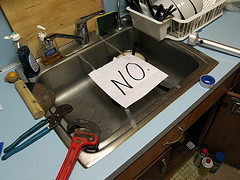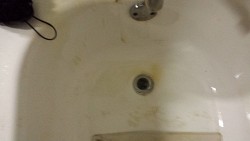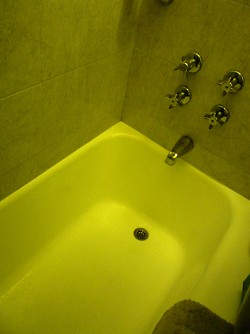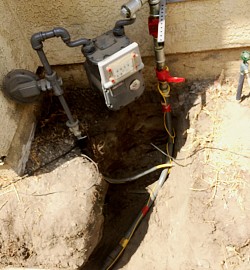13 Things You Must Know About Household Plumbing Leaks
 Aggh! Plumbing leaks are so frustrating. They make your utility bills shoot up for no good reason, waste precious water, and ultimately can destroy your home sweet home. Frustrating indeed … particularly because someone with a little know-how can usually track down this type of leak relatively simply and inexpensively. So why not start building up your knowledge right now? Here are 13 things every homeowner (and renter) should know about plumbing leaks.
Aggh! Plumbing leaks are so frustrating. They make your utility bills shoot up for no good reason, waste precious water, and ultimately can destroy your home sweet home. Frustrating indeed … particularly because someone with a little know-how can usually track down this type of leak relatively simply and inexpensively. So why not start building up your knowledge right now? Here are 13 things every homeowner (and renter) should know about plumbing leaks.
- Plumbing leaks are responsible for 3,000,000,000,000 (yes, three trillion!) gallons of water wastage and over $6 billion worth of property damage every year. And those figures, my friend, are in the United States alone.
- The consequences of failing to detect or repair a leak in your plumbing are very serious. Wood and drywall can rot, a mold problem may develop, and your home's foundation could be compromised.
- On the other hand, the cost to take care of a single leak is relatively low, averaging about $225-325 to find and fix it, a sum which may be covered, at least in part, by your homeowner's insurance.
- In a large number of cases, it is notoriously difficult to detect plumbing leaks in your home. For this reason, you are well advised to carefully check your water company statement every month. A water bill that is exceptionally high could be your first indication that a pipe or fixture is leaking.
- It's a smart idea to keep on the alert for gurgling or hissing noises or the sound of running water even when no plumbing is being used. All of these may be audio signals that you have a leak somewhere. Use your ears to try to pinpoint where it is.
- Speaking of using your ears, professional plumbers these days have a whole toolbox full of sophisticated gadgets at their disposal to help with leak detection. Interestingly enough, most of these newfangled tools are designed to work with the sense of hearing, for example, an ultra-modern leak detection amplifier, complete with headphones.
- If you suspect a leak, you can detect it by making sure that no water is running in the house. Then watch your water meter for a minute or two. The indicator should not budge -- if it moves, that's a sign that a plumbing leak needs repair. Next, close the water supply main shut-off valve. If the dial continues turning, the leak is outside between the valve and the meter. Otherwise, it is in your indoor plumbing system.
- Thinking of buying a house? Be sure to have it checked for leaks before you sign on the dotted line.
- Toilets are the most common sources of plumbing leaks.
- Everyone in your household should be taught how to turn off the water supply in case of emergency (such as a burst pipe) -- or how to get help fast.
- The tank of your water heater is equipped with a pressure relief valve. If it springs a leak, this may not be obvious to you, because it could be plumbed straight into a drain.
- If part of your floor feels hot to the touch, take note of the spot; you just might have hot water pipe leakage right underfoot.
- A new type of smart home device, marketed under several different names, has recently been released. This extremely useful gizmo can be used to monitor what's happening to the water in your home, sounding an alarm and shutting off the feed water supply when it detects a leak or frozen pipe. Some models are also capable of tracking your household's water usage data over time, allowing you to set usage goals and reduce wastage.
Laura Firszt writes for networx.com.
Looking for a Pro? Call us (866) 441-6648

Plumbing Average Costs
Plumbers Experiences

Clearing A Bathtub Drain Makes It Run Smoother Than Ever

My Remodeled Bathroom Is Modern, Clean And Beautiful

Gas Line Installation Made Simple
Top Cities Covered by our Plumbers
Austin
| Boston
| Charlotte
| Chicago
| Columbus
| Dallas
| Denver
| Detroit
| El Paso
| Fort Worth
| Houston
| Indianapolis
| Jacksonville
| Los Angeles
| Memphis
| Nashville
| New York
| Philadelphia
| Phoenix
| Portland
| San Antonio
| San Diego
| San Francisco
| San Jose
| Seattle
| Washington


